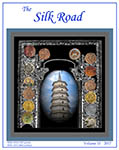|
| |
| From the editor’s desk: Hail and Farewell
| iii |
|
Download |
| |
| Dedication
| ix |
|
Download |
| |
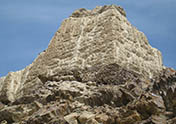 
|
Raising the Alarm: Defensive Communication Networks and the Silk Roads through Wakhan and Chitral |
1 |
| by John Mock |
Download |
| A fortress network in the Wakhan and Chitral areas of Afghanistan and Northern Pakistan was important in defense against Chinese penetration of the region under the Tang Dynasty. The information and photographs here are based on recent visits to the sites.
|
|
| |
|
| Caravanserais in the Golden Horde
| 13 |
| by Emma D. Zilivinskaia |
Download |
| Given the significance of international trade for the Mongol Golden Horde, the existence of caravanserais to accommodate travelers along key routes is a subject of considerable interest. The focus here is on the network across the forbidding Ustiurt Plateau from Central Asia to the northern end of the Caspian.
|
| |
| A Photo Essay: Sasanian Bishapur and its Rock Reliefs
| 32 |
| by Daniel C. Waugh |
Download |
| As an early capital of the Sasanian Empire, Bishapur in Iran was provided with an array of rock reliefs celebrating the victories of the kings and their investiture by the gods.
|
| |
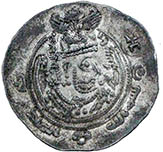 
|
The Silk Road and the Economy of Gaochang: Evidence n the Circulation of Silver Coins
| 39 |
| by Pei Chengguo |
Download |
| While the presence of Sogdian merchants in the Turpan region is now well known, the degree to which silver coinage (for the most part from Iran) was used in the local economy requires further study, key information found in the documents analyzed and translated here.
|
|
| |
| The Central Asian Ties of a Tenth-Century Muslim Ruler in Egypt
| 59 |
| by Jere L. Bacharach |
Download |
| Slave soldiers from Central Asia often rose to power in the Islamic world, the example here being one of the rulers of Egypt in the 10th century CE who sought to emphasize his Central Asian family heritage in his titulature and coinage. |
| |
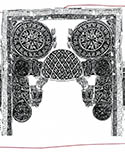 
|
Décor of the Eighth-Century Turkic Rulers' Residence in the Citadel of Kulan Town | 65 |
| by Serik Sh. Akylbek, Erbulat A. Smagulov, and Sergey Yatsenko |
Download |
| The important urban site of Kulan in southeastern Kazakhstan has been the focus of new excavations, which uncovered in the citadel a palace structure decorated with carved clay and painting and including interesting graffiti. |
|
| |
| A Photo Essay:Light on the Liao
| 83 |
| by Daniel C. Waugh |
Download |
| In recent years, the Kitan/Liao, who ruled in northern China in the late 10th to the 12th centuries have been getting their due. This photo essay highlights how interesting Liao material is for any study of the Silk Roads.. |
| |
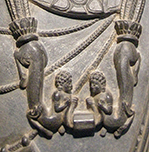 
| Tamed by Religion: Centaurs in Gandhara. A unique sculpted necklace of a Gandharan schist Bodhisattva Maitreya in the Asian Art Museum, San Francisco
| 107 |
| by Ulf Jäger |
Download |
| Buddhist sculpture from Gandhara is in a sense well known, but there is still much to be learned from it. The focus here is on sculpted imagery on a necklace, which leads into the subject of how centaurs are to be found across Eurasia and how the perception of them changed.
|
|
| |
| An Analysis of the Early Unified Silla Bas-relief of Pearl Roundel, Tree of Life, Peacocks, and Lion from the Gyeongju National Museum, Korea | 116 |
| by Hongnam Kim |
Download |
| A carved granite slab in the Gyeongju National Museum in Korea has images in roundels whose iconography suggests widely ranging connections to the West in the Unified Silla period. It is likely that the craftsman who executed the work was familiar with Christian imagery.
|
| |
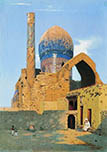 
|
A Relic from Samarkand in the Urals
| 134 |
| by Rustam Ganiev, Anton Kochnev, Konstantin Anikin, and Nikolai Neuimin |
Download |
| A Russian officer obtained in Samarkand at the time of its conquest in 1868 a piece of the original 15th-century lattice fence from around the cenotaphs in the Timurid Gur-e Amir Mausoleum. The relic is now in the museum in Ekaterinburg.
|
|
| |
| The Tumu Incident and the Chinggisid Legacy in Inner Asia | 142 |
| by Johan Elverskog |
Download |
| When the Oirad Mongols defeated the Ming and captured their emperor at Tumu in 1449, they could have invaded Central China and perhaps brought down the still young Ming state, but did not. The significance of the Chingissid legacy both for the Mongols and the Ming helps to explain why.
|
| |
| Exploring the Origins of Horse Herding and Riding in the Mongolian Steppe
| 153 |
| by William Taylor, Tumurbaatar Tuvshinjargal, and Jamsranjav Bayarsaikhan |
Download |
A brief report concerning ongoing research in Mongolia that is providing new evidence about the emergence of horse domestication and riding.
|
| |
Symposia reports:
Short report on the symposium “From Khotan to Dunhuang—Case Studies of History and Art along the Silk Road” held 13.6-14.6.2017 at the Eötvös Loránd University (ELTE), Budapest, Hungary
| 156
Download |
| by Lilla Russell_Smith |
Art and Archaeology of the Silk Road, a symposium on October 11-13, 2017, at Portland State University, Portland, OR, USA
| |
| by Daniel C. Waugh |
| |
On-line resources:
Two at Oxford
Gary Lee Todd's World History Photos
Dick Osseman's Pictures of Turkey, Syria and Jordan
| 159
Download |
| by Daniel C.Waugh |
| |
| |
| Book Reviews (by Daniel C. Waugh)
| 163
Download |
| von Folsach and Meyer, The Human Figure in Islamic Art: Holy Men, Princes, and Commoners |
| |
| Russell-Smith and Konczak-Nagel, The Ruins of Kocho: Traces of Wooden Architecture on the Ancient Silk Road | 167 |
| |
| Munshi Abdul Rahim: Forgotten Hero of the Great Game (rev. of Kreutzmann, Wakhan Quadrangle: Exploration and espionage during and after the Great Game
| 171 |
| |
, Vol. 15 (2017),







